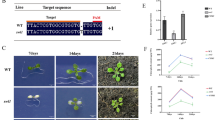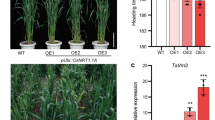Abstract
Key message
MfLEA3 is involved in protection of catalase activity and confers multiple abiotic stress tolerance.
Abstract
Late embryogenesis abundant (LEA) proteins are involved in plant growth, development and abiotic stress tolerance. A member of group 3 LEA proteins from Medicago sativa subsp. falcata (L.) Arcang, MfLEA3, was investigated in the study. MfLEA3 transcript was induced in response to cold, dehydration, and abscisic acid (ABA), while the cold-induced transcript of MfLEA3 was blocked by pretreatment with inhibitor of ABA synthesis. Constitutive expression of MfLEA3 led to enhanced tolerance to cold, drought, and high-light stress in transgenic tobacco plants. Compared to accumulated reactive oxygen species (ROS) in the wild-type in response to treatments with low temperature, drought, and high light, ROS were not accumulated in transgenic plants. Superoxide dismutase, catalase (CAT), and ascorbate-peroxidase activities were increased in all plants after treatments with the above stresses, while higher CAT activity was maintained in transgenic plants compared with wild-type. However, transcript level of CAT-encoding genes including CAT1, CAT2, and CAT3 showed no significant difference between transgenic plants and wild-type, indicating that the higher CAT activity was not associated with its gene expression. ABA sensitivity and transcripts of several ABA and stress-responsive genes showed no difference between transgenic plant and wild-type, indicating that ABA signaling was not affected by constitutive expression of MfLEA3. The results suggest that MfLEA3 may be involved in the protection of CAT activity and confers multiple abiotic stress tolerance.







Similar content being viewed by others
References
Battaglia M, Olvera-Carrillo Y, Garciarrubio A, Campos F, Covarrubias AA (2008) The enigmatic LEA proteins and other hydrophilins. Plant Physiol 148:6–24
Candat A, Paszkiewicz G, Neveu M, Gautier R, Logan DC, Avelange-Macherel M-H, Macherel D (2014) The ubiquitous distribution of late embryogenesis abundant proteins across cell compartments in Arabidopsis offers tailored protection against abiotic stress. Plant Cell 26:3148–3166
Chakrabortee S, Boschetti C, Walton LJ, Sarkar S, Rubinsztein DC, Tunnacliffe A (2007) Hydrophilic protein associated with desiccation tolerance exhibits broad protein stabilization function. Proc Natl Acad Sci USA 104:18073–18078
Chen Y, Li C, Zhang B, Yi J, Yang Y, Kong C, Lei C, Gong M (2019) The role of the late embryogenesis-abundant (LEA) protein family in development and the abiotic stress response: a comprehensive expression analysis of potato (Solanum tuberosum). Genes 10(2):148
Dubé M-P, Castonguay Y, Cloutier J, Michaud J, Bertrand A (2013) Characterization of two novel cold-inducible K3 dehydrin genes from alfalfa (Medicago sativa spp. sativa L.). Theor Appl Genet 126:823–835
Furuki T, Sakurai M (2016) Group 3 LEA protein model peptides protect enzymes against desiccation stress. Biochim Biophys Acta 1864:1237–1243
Guo Z, Tan J, Zhuo C, Wang C, Xiang B, Wang Z (2014) Abscisic acid, H2O2 and nitric oxide interactions mediated cold-induced S-adenosylmethionine synthetase in Medicago sativa subsp. falcata that confers cold tolerance through up-regulating polyamine oxidation. Plant Biotech J 12:601–612
He X, Sambe MA, Zhuo C, Tu Q, Guo Z (2015) A temperature induced lipocalin gene from Medicago falcata (MfTIL1) confers tolerance to cold and oxidative stress. Plant Mol Biol 87:645–654
Hernández-Sánchez IE, Martynowicz DM, Rodríguez-Hernández AA, Pérez-Morales MB, Graether SP, Jiménez-Bremont JF (2014) A dehydrin-dehydrin interaction: the case of SK3 from Opuntia streptacantha. Front Plant Sci 5:520
Huang L, Zhang M, Jia J, Zhao X, Huang X, Ji E, Ni L, Jiang M (2018) An atypical late embryogenesis abundant protein OsLEA5 plays a positive role in ABA-induced antioxidant defense in Oryza Sativa L. Plant Cell Physiol 59:916–929
Knight MR, Knight H (2012) Low temperature perception leading to gene expression and cold tolerance in higher plants. New Phytol 195:737–751
Liang Y, Kang K, Gan L, Ning S, Xiong J, Song S, Xi L, Lai S, Yin Y, Gu J, Xiang J, Li S, Wang B, Li M (2019) Drought-responsive genes, late embryogenesis abundant group3 (LEA 3) and vicinal oxygen chelate, function in lipid accumulation in Brassica napus and Arabidopsis mainly via enhancing photosynthetic efficiency and reducing ROS. Plant Biotechnol J 17:2123–2142
Lim C, Lim S, Baek W, Lee S (2015) The pepper late embryogenesis abundant protein CaLEA1 acts in regulating abscisic acid signaling, drought and salt stress response. Physiol Plant 154:526–542
Liu H, Xing M, Yang W, Mu X, Wang X, Lu F, Wang Y, Zhang L (2019) Genome-wide identification of and functional insights into the late embryogenesis abundant (LEA) gene family in bread wheat (Triticum aestivum). Sci Rep 9(1):1–11
Liu Y, Liang J, Sun L, Yang X, Li D (2016) Group 3 LEA protein, ZmLEA3, is involved in protection from low temperature stress. Front Plant Sci 7:1011
Liu Y, Wang L, Xing X, Sun L, Pan J, Kong X, Zhang M, Li D (2013) ZmLEA3, a multifunctional group 3 LEA protein from maize (Zea mays L.), is involved in biotic and abiotic stresses. Plant Cell Physiol 54:944–959
Liu Y, Xie L, Liang X, Zhang S (2015) CpLEA5, the late embryogenesis abundant protein gene from Chimonanthus praecox, possesses low temperature and osmotic resistances in prokaryote and eukaryotes. Int J Mol Sci 16:26978–26990
Liu Y, Zheng Y, Zhang Y, Wang W, Li R (2010) Soybean PM2 protein (LEA3) confers the tolerance of Escherichia coli and stabilization of enzyme activity under diverse stresses. Curr Microbiol 60:373–378
Magwanga RO, Lu P, Kirungu JN, Lu H, Wang X, Cai X, Zhou Z, Zhang Z, Salih H, Wang K, Liu F (2018) Characterization of the late embryogenesis abundant (LEA) proteins family and their role in drought stress tolerance in upland cotton. BMC Genet 19:6
Pang C, Wang C, Chen H, Guo Z, Li C (2009) Transcript profiling of cold responsive genes in Medicago falcate. In: Yamada T, Spangenberg G (eds) Molecular breeding of forage and turf. Springer, New York, pp 141–149
Pedrosa AM, Martins CdPS, Gonçalves LP, Costa MGC (2015) Late embryogenesis abundant (LEA) constitutes a large and diverse family of proteins involved in development and abiotic stress responses in sweet orange (Citrus sinensis L. Osb.). PLoS ONE 10:e0145785
Pennycooke JC, Cheng H, Stockinger EJ (2008) Comparative genomic sequence and expression analyses of Medicago truncatula and alfalfa subspecies falcata COLD-ACCLIMATION-SPECIFIC genes. Plant Physiol 146:1242–1254
Popova AV, Rausch S, Hundertmark M, Gibon Y, Hincha DK (2015) The intrinsically disordered protein LEA7 from Arabidopsis thaliana protects the isolated enzyme lactate dehydrogenase and enzymes in a soluble leaf proteome during freezing and drying. Biochim Biophys Acta 1854:1517–1525
Rémus-Borel W, Castonguay Y, Cloutier J, Michaud R, Bertrand A, Desgagnés R, Laberge S (2010) Dehydrin variants associated with superior freezing tolerance in alfalfa (Medicago sativa L.). Theor Appl Genet 120:1163–1174
Riday H, Brummer EC (2002) Forage yield heterosis in alfalfa. Crop Sci 42:716–723
Riday H, Brummer EC, Campbell TA (2003) Comparisons of genetic and morphological distance with heterosis between Medicago sativa, subsp. sativa, and subsp. falcata. Euphytica 131:37–45
Sambe MAN, He X, Tu Q, Guo Z (2015) A cold-induced myo-inositol transporter like gene (MfINT-like) confers tolerance to multiple abiotic stresses in transgenic tobacco plants. Physiol Plant 153:355–364
Shi Y, Ding Y, Yang S (2015) Cold signal transduction and its interplay with phytohormones during cold acclimation. Plant Cell Physiol 56:7–15
Suzuki N, Koussevitzky S, Mittler R, Miller G (2012) ROS and redox signaling in the response of plants to abiotic stress. Plant Cell Environ 35:259–270
Suzuki N, Mittler R (2006) Reactive oxygen species and temperature stresses: a delicate balance between signaling and destruction. Plant Physiol 126:45–51
Tan J, Wang C, Xiang B, Han R, Guo Z (2013) Hydrogen peroxide and nitric oxide mediated cold- and dehydration-induced myo-inositol phosphate synthase that confers multiple resistances to abiotic stresses. Plant Cell Environ 36:288–299
Wang Y, Jiang J, Zhao X (2006) A novel LEA gene from Tamarix androssowii confers drought tolerance in transgenic tobacco. Plant Sci 171:655–662
Wang M, Li P, Li C, Pan Y, Jiang X, Zhu D, Zhao Q, Yu J (2014) SiLEA14, a novel atypical LEA protein, confers abiotic stress resistance in foxtail millet. BMC Plant Biol 14:290
Xin Z, Browse J (2010) Cold comfort farm: the acclimation of plants to freezing temperatures. Plant Cell Environ 23:893–902
Xu M, Tong Q, Wang Y, Wang Z, Xu G, Elias GK, Li S, Liang Z (2020) Transcriptomic analysis of grapevine LEA gene family in response to osmotic and cold stress, and functional analyses of VamDHN3 gene. Plant Cell Physiol 9:13375
Yang J, Guo Z (2007) Cloning of a 9-cis-epoxycarotenoid dioxygenase gene (SgNCED1) from Stylosanthes guianensis and its expression in response to abiotic stresses. Plant Cell Rep 26:1383–1390
Zhang P, Li S, Zhao P, Guo Z, Lu S (2019) Comparative physiological analysis reveals the role of NR-derived nitric oxide in the cold tolerance of forage legumes. Int J Mol Sci 20:1368
Zhao P, Liu F, Ma M, Gong J, Wang Q, Jia P, Zheng G, Liu H (2011) Overexpression of AtLEA3-3 confers resistance to cold stress in Escherichia coli and provides enhanced osmotic stress tolerance and ABA sensitivity in Arabidopsis thaliana. Mol Biol 45:785–796
Zhuo C, Liang L, Zhao Y, Guo Z, Lu S (2018) A cold responsive ethylene responsive factor from Medicago falcata confers cold tolerance by up-regulation of polyamine turnover, antioxidant protection, and proline accumulation. Plant Cell Environ 41:2021–2032
Zhuo C, Wang T, Lu S, Zhao Y, Li X, Guo Z (2013) A cold responsive galactinol synthase gene from Medicago falcata (MfGolS1) is induced by myo-inositol and confers multiple tolerances to abiotic stresses. Physiol Plant 149:67–78
Zhuo C, Wang T, Guo Z, Lu S (2016) Overexpression of MfPIP2-7 from Medicago falcata promotes cold tolerance and growth under NO3− deficiency in transgenic tobacco plants. BMC Plant Biol 16:138
Acknowledgements
The research was supported by the National Natural Science Foundation of China (31672481, 31701961), Chinese Agriculture Research System-Green Manure (CARS-22-G-04), and the Natural Science Foundation of Jiangsu Province (Grant no. BK20160728).
Author information
Authors and Affiliations
Contributions
HS, XH, and JZ performed research and conducted data analyses. ZG and SL designed the research. HS and ZG wrote the manuscript.
Corresponding author
Ethics declarations
Conflict of interest
The authors declare that they have no conflict of interests.
Additional information
Communicated by Prakash P. Kumar.
Publisher's Note
Springer Nature remains neutral with regard to jurisdictional claims in published maps and institutional affiliations.
Electronic supplementary material
Below is the link to the electronic supplementary material.
Fig. S1.
Superoxide dismutase (SOD, a) and ascorbate-peroxidase (APX, b) activities in transgenic plants in comparison with the wild-type (WT) in response to abiotic stresses (PDF 1037 kb)
Fig. S2.
Analysis of transcript levels of NtDREB1 (a), NtDREB2 (b), NtDREB3 (c), NtDREB4 (d), NtERD10B (e), NtCOR15a (f), NtP5CS (g) in the transgenic tobacco plants in comparison with the wild-type (WT). The relative expression level was normalized to that of MfACTIN or MtACTIN. The same letter above the columns indicates no significant difference at P < 0.05. (PDF 3256 kb)
Fig. S3.
Analysis of ABA sensitivity in MfLEA3 transgenic plants in comparison with the wild-type. Seedling phenotypes (a) and shoot fresh weight (b) were recorded after 1-month of growing on 1/2 MS containing different concentrations of ABA. Roots phenotype (c) and root length (d) were recorded after ten-day of growing on 1/2 MS containing different concentrations of ABA. Three independent experiments were executed. Bar = 1 cm. Means of three biological replicates and standard errors are presented; the same letter above the column indicates no significant difference at P < 0.05 (PDF 318 kb)
Rights and permissions
About this article
Cite this article
Shi, H., He, X., Zhao, Y. et al. Constitutive expression of a group 3 LEA protein from Medicago falcata (MfLEA3) increases cold and drought tolerance in transgenic tobacco. Plant Cell Rep 39, 851–860 (2020). https://doi.org/10.1007/s00299-020-02534-y
Received:
Accepted:
Published:
Issue Date:
DOI: https://doi.org/10.1007/s00299-020-02534-y




